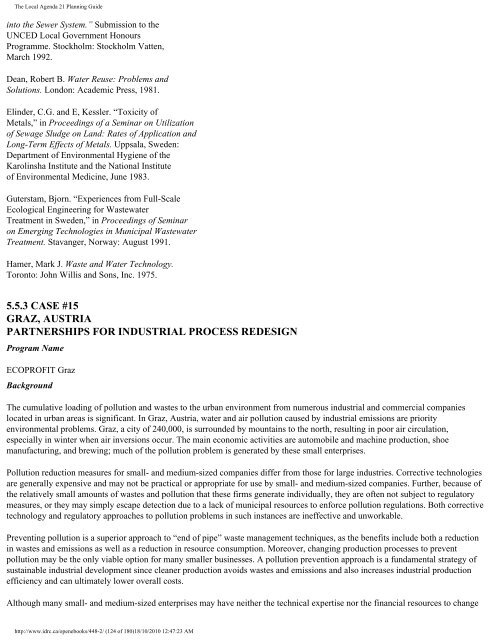The Local Agenda 21 Planning Guide - Democrats Against UN ...
The Local Agenda 21 Planning Guide - Democrats Against UN ...
The Local Agenda 21 Planning Guide - Democrats Against UN ...
You also want an ePaper? Increase the reach of your titles
YUMPU automatically turns print PDFs into web optimized ePapers that Google loves.
<strong>The</strong> <strong>Local</strong> <strong>Agenda</strong> <strong>21</strong> <strong>Planning</strong> <strong>Guide</strong><br />
into the Sewer System.” Submission to the<br />
<strong>UN</strong>CED <strong>Local</strong> Government Honours<br />
Programme. Stockholm: Stockholm Vatten,<br />
March 1992.<br />
Dean, Robert B. Water Reuse: Problems and<br />
Solutions. London: Academic Press, 1981.<br />
Elinder, C.G. and E, Kessler. “Toxicity of<br />
Metals,” in Proceedings of a Seminar on Utilization<br />
of Sewage Sludge on Land: Rates of Application and<br />
Long-Term Effects of Metals. Uppsala, Sweden:<br />
Department of Environmental Hygiene of the<br />
Karolinsha Institute and the National Institute<br />
of Environmental Medicine, June 1983.<br />
Guterstam, Bjorn. “Experiences from Full-Scale<br />
Ecological Engineering for Wastewater<br />
Treatment in Sweden,” in Proceedings of Seminar<br />
on Emerging Technologies in Municipal Wastewater<br />
Treatment. Stavanger, Norway: August 1991.<br />
Hamer, Mark J. Waste and Water Technology.<br />
Toronto: John Willis and Sons, Inc. 1975.<br />
5.5.3 CASE #15<br />
GRAZ, AUSTRIA<br />
PARTNERSHIPS FOR INDUSTRIAL PROCESS REDESIGN<br />
Program Name<br />
ECOPROFIT Graz<br />
Background<br />
<strong>The</strong> cumulative loading of pollution and wastes to the urban environment from numerous industrial and commercial companies<br />
located in urban areas is significant. In Graz, Austria, water and air pollution caused by industrial emissions are priority<br />
environmental problems. Graz, a city of 240,000, is surrounded by mountains to the north, resulting in poor air circulation,<br />
especially in winter when air inversions occur. <strong>The</strong> main economic activities are automobile and machine production, shoe<br />
manufacturing, and brewing; much of the pollution problem is generated by these small enterprises.<br />
Pollution reduction measures for small- and medium-sized companies differ from those for large industries. Corrective technologies<br />
are generally expensive and may not be practical or appropriate for use by small- and medium-sized companies. Further, because of<br />
the relatively small amounts of wastes and pollution that these firms generate individually, they are often not subject to regulatory<br />
measures, or they may simply escape detection due to a lack of municipal resources to enforce pollution regulations. Both corrective<br />
technology and regulatory approaches to pollution problems in such instances are ineffective and unworkable.<br />
Preventing pollution is a superior approach to “end of pipe” waste management techniques, as the benefits include both a reduction<br />
in wastes and emissions as well as a reduction in resource consumption. Moreover, changing production processes to prevent<br />
pollution may be the only viable option for many smaller businesses. A pollution prevention approach is a fundamental strategy of<br />
sustainable industrial development since cleaner production avoids wastes and emissions and also increases industrial production<br />
efficiency and can ultimately lower overall costs.<br />
Although many small- and medium-sized enterprises may have neither the technical expertise nor the financial resources to change<br />
http://www.idrc.ca/openebooks/448-2/ (124 of 180)18/10/2010 12:47:23 AM










